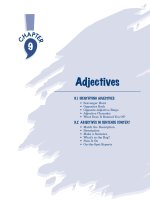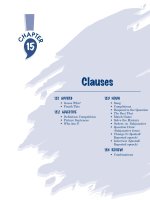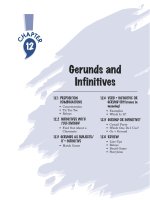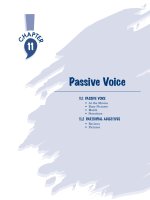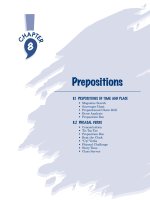fun With Grammar - Clauses
Bạn đang xem bản rút gọn của tài liệu. Xem và tải ngay bản đầy đủ của tài liệu tại đây (338.41 KB, 26 trang )
15.1 ADVERB
• Guess Who?
• Finish This
15.2 ADJECTIVE
• Definition Competition
• Picture Sentences
• Who Am I?
15.3 NOUN
•Song
• Completions
• Respond to the Question
• The Fact That
• Match Game
• Solve the Mystery
• Orders Subjunctive
• Question Draw
(Subjunctive form)
• Change It (Quoted/
Reported speech)
• Interview (Quoted/
Reported speech)
15.4 REVIEW
• Combinations
Clauses
15
283
15.1 ADVERB
1. GUESS WHO?
Materials:
None
Dynamic:
Whole class/Groups
Time:
20 minutes
Procedure:
1. Write 10 phrases on the board.
Examples: borrow money eat pizza
have my first kiss eat too much
go to a movie go to bed
go out to eat go dancing
go to the mall stay up late
2. Instruct the students to write a sentence using each of the phrases
and an adverbial subordinator. The sentences may use any logical
tense/time. You may want to list adverbial subordinators on the
board.
Examples: I borrowed money after I lost my wallet.
I had my first kiss when I was 14 years old.
3. Collect individual papers as they are completed. You can be noting
unusual sentences to read aloud and have the class guess who
wrote them.
Variation 1:
As a follow-up activity, you can use the students’ sentences to create a
game to review adverbial subordinators at the end of the unit. Divide
the sentences into two columns with the main clause on the left and
the dependent clause (with the adverbial subordinator) on the right.
Cut them apart and mix them up. Divide the class into teams and
hand out the strips containing clauses to the teams. Have the students
make as many logical sentences as possible. (It is not necessary to
duplicate the original sentences as long as the ones they create as a
team are logical.) The team with the most logical sentences wins.
Variation 2:
Give 20 cards or slips of paper to each group. Have them write 10
sentences, with the adverb clause on one paper and the independent
clause on another. Collect the 20 papers from each group and give
them to a different group. Tell the groups to match the independent
and dependent clauses written by the other group. The first group who
matches all the clauses to form logical sentences wins. (It is not
absolutely necessary to match every sentence as it was written, but it
may not be possible to come up with 10 logical sentences otherwise.)
2. FINISH THIS
Materials:
None
Dynamic:
Small groups
Time:
15 minutes
Procedure:
1. Divide the class into groups of three or four. Each group makes a
list of clauses containing an adverbial subordinator. (The number
of clauses you want your students to list will depend on how much
time you have for this activity.)
Examples: I get scared when
Before I got to class,
I always eat pizza after
2. To play a round, Group 1 reads one of its clauses for Group 2.
Group 2 must complete the sentence. If they do so correctly, they
get a point.
3. Group 2 then reads a sentence for Group 3 to complete. Continue
until all clauses have been completed.
15.2 ADJECTIVE
1. DEFINITION COMPETITION
Materials:
Slips of paper, a noun written on each
A paper bag
Dynamic:
Teams
Time:
15 minutes
Procedure:
1. Use a variety of nouns that denote things, people, places, time
periods (months or holidays), and so on. Put the slips of paper into
the bag and divide the class into two teams.
2. A student from the first team comes to the front and picks a paper
from the bag. The student then gives his/her teammates one clue
about the noun, using the phrase “I’m thinking of a thing
(person/place/animal/etc.) . . .” and an adjective clause to complete
the clue. It is helpful if you write this starting phrase on the board.
Sample clue: I am thinking of an animal that is orange with
black stripes.
284
285
3. After the first clue has been given, the first person on the clue-
giver’s team to raise his/her hand can guess the noun. If the
answer is correct, his/her team gets a point. If the answer is
incorrect, the clue-giver gives another clue, again using an
adjective clause. This time, anyone on either team may guess, and
the team of the person who answers correctly gets the point.
4. Repeat steps 2 and 3 with a student from the other team.
Continue alternating between teams. The team with the most
points at the end wins.
2. PICTURE SENTENCES
Materials:
Large pictures
Dynamic:
Pairs
Time:
10 minutes
Procedure:
1. Try to find full-page ads that can be seen when held up. Put
students into pairs, and give each pair a picture.
2. Have the pairs write a sentence containing an adjective clause
about their picture.
Example: The man who is next to the president is holding a
book.
3. The pairs hold up their pictures and read their sentences to the
class.
4. Last, the pairs write a reduction of their sentence, if possible.
Example: The man next to the president is holding a book.
3. WHO AM I?
Materials:
Slips of paper, each containing the name
of a different student in the class
Dynamic:
Whole class
Time:
25 minutes
Procedure:
1. Tell the students that you are going to take on the identity of one of
them. Choose a student and then describe yourself as if you were
that student. Use physical and personality details and the structure
“I am someone who . . .” or “I am the kind of person who . . .”
2. Distribute the slips of paper. Each student is to take on the
identity of the name on his/her paper and write five sentences to
describe himself/herself, using the structure indicated above.
3. Have the class get up and circulate. They must try to find
themselves in the crowd by listening to other students describe
themselves in the new identity. (You can circulate and listen for
examples and errors.)
4. The first person to find himself/herself is the winner, but have
everyone find himself/herself before you stop play if time permits.
NOTE: This activity works best with a class that has worked
together for awhile and who are familiar with one another.
15.3 NOUN
1. SONG
Materials:
Worksheet 94
Tape player and music
Dynamic:
Pairs
Time:
10 minutes
Procedure:
1. Tell students that you are going to play a song. They are to listen
for noun clauses and count them. Remind the students that there
can be clauses where “that” has been eliminated. Play the song
once.
2. Ask how many noun clauses were heard. Get several answers.
Play the song again, if desired, and recount.
3. Put students in pairs and give each pair a copy of the worksheet.
4. Have the pairs go through the song lyrics and underline all the
noun clauses.
5. Go through the words together and have the students identify
each noun clause as you come to it.
NOTE: The lyrics to “Amie” (Craig Fuller, sung by Pure Prairie
League) are provided in the worksheet as an example. If you do not
have the music, you could read it to your students, but it is best to
find a song with noun clauses for which you have the music.
Another good song to use is “Don’t Pass Me By” (Richard Starkey,
sung by the Beatles).
286
287
2. COMPLETIONS
Materials:
Worksheet 95
Dynamic:
Pairs
Time:
10 minutes
Procedure:
1. Put the students in pairs. Give each pair a copy of the worksheet
containing the six sentence fragments that they should complete
with a noun clause. Encourage them to use the names of students
from the class in their completions and to be silly if they want. You
may also suggest a topic for the sentences.
SUGGESTIONS: your classmates
elephants
outer space
another country
the opposite sex
unusual animals
2. Go around the class and have the pairs read their sentence
completions. You may also want to see if any of the students can
respond to a completed sentence. For example, if one pair writes “I
wonder why Marissa was absent today,” you may ask if anyone
knows why.
3. RESPOND TO THE QUESTION
Materials:
Worksheets 96, cut into strips
Dynamic:
Whole class/Teams
Time:
10 minutes
Procedure:
1. Give each student a strip with a question on it. If you use the
worksheet, fill in the blanks with the names of students from your
class. The students are to respond to the question, using a noun
clause.
Example:
On the strip: How many people live in Miami?
Possible responses:
I don’t know how many people live in Miami.
I don’t care how many people live in Miami.
Who knows how many people live in Miami? etc.
2. Have students take turns reading their question and their answer.
Variation:
Divide the class into teams and have the students draw strips
alternately. If a student answers the question correctly (correct noun
clause form), the team gets a point. If you allow the team to work
together on the answer, accept the answer only from the student
who drew the strip.
4. THE FACT THAT
Materials:
Worksheet 97
Dynamic:
Pairs
Time:
15 minutes
Procedure:
1. To review noun clauses using the fact that, divide the class into
pairs. Give each pair a copy of the worksheet and have them work
together to combine the two sentences using “the fact that.”
2. Have each pair write one answer on the board. The other students
will critique the answers (Do the sentences combine the two
sentences grammatically? logically?).
5. MATCH GAME
Materials:
Worksheet 98
Dynamic:
Small groups
Time:
20 minutes
Procedure:
1. To review noun clauses, put students into groups of three to five.
Cut up the worksheet and randomly distribute cards to the groups.
Because the groups need to make matches, give an even number of
cards to each group even if one or two groups receive two more
cards than another group.
2. Each group tries to match its cards to make sentences that are
both grammatical and logical, observing the capitalization on the
cards (that is, they cannot change the capitalization).
3. Because cards were given out randomly, some of the cards will not
form matches. After making all the matches they can within their
groups, the students try to trade with other groups. They cannot
just take a card from another group, but must trade them. If one
group is unwilling to trade a certain card, the other group cannot
force them.
4. When one group has made all its matches and feels they are
correct, the game stops. One member of the group reads out the
matches to see if the class accepts the match. (You may need to
referee if the class rejects a logical, grammatical answer.
Sometimes this happens if the class does not want the group to
win [and thus the game to end].)
288
289
5. If all matches are accepted, the group wins. If any of the matches
is rejected, the game continues until another (or the same) group
feels it has matched all cards. There can be no unmatched cards.
6. SOLVE THE MYSTERY
Materials:
Worksheets 99A and 99B or a 3”x5” card
for each student and a list of information
the students must obtain
A piece of paper for each student
Dynamic:
Whole class
Time:
30 minutes
Procedure:
1. Copy and cut Worksheet 99A, making sure there will be one card
for each of your students. The first seven cards must be used. Use
as many of the others as you have students in the class. (You may
have to duplicate the worksheet or make others yourself if you
have a large class.) If you choose not to use the worksheet, make
cards with similar information on them.
2. Have the students number their papers 1–7, and ask them to
write the following information:
1. the name of a student in the class
2. the name of a thing that can be carried
3. the name of another student in the class
4. a money amount
5. complete the sentence: He/She did it because ...
6. the name of another student in the class
7. a location in your house
3. Collect the papers and draw seven at random. Use a different
student paper to fill in the information on the first seven cards on
the worksheet. (Take the name of a student in the class from the
first paper, the name of a thing that can be carried from the second
paper, the name of another student in the class from the third
paper, and so on.)
4. Distribute the cards randomly so that seven students have a clue
card (with the blank now filled in) and the rest of the students
have the other cards from the worksheet. Tell the students that a
crime has been committed and they must solve the crime by
finding the answer to the questions on Worksheet 99B. Either give
each student a copy of the questions, or write the questions on the
board or on an overhead transparency.
5. The students circulate and ask each other the questions, making
sure to preface each question with an expression such as “Can you
please tell me . . .?” or “Do you know . . .?” with the rest of the
question converted into a noun clause.
Example: “Whose was it?” becomes “Do you know whose it was?”
If the question is not phrased properly, the student being asked
may refuse to answer the question. Students who have the
requested information must respond to a correctly worded
question truthfully. Students who do not have the answer must
use the phrase on their cards, followed by a noun clause.
Example: I don’t know how much it costs.
I don’t have the foggiest idea who stole it.
6. The first student to acquire all of the requested information wins.
7. ORDERS SUBJUNCTIVE
Materials:
Worksheet 100
Dynamic:
Teams
Time:
10 minutes
Procedure:
1. Cut up the worksheet. Divide the class into two teams and have
them line up on either side of the room.
2. The first student from Team 1 comes to the front desk and draws a
slip of paper with an order on it. The student then puts that order
into a subjunctive sentence. Tell students not to repeat the same
verb used by their classmates, but to use a variety: demand, tell,
order, ask, etc.
Example:
Paper: Teacher to student: “Shut the door.”
Student response: She demanded that the student shut the
door.
3. If the student answers correctly, he/she scores a point for his/her
team. Then the other team takes a turn.
4. Repeat until all orders have been put into the subjunctive. The
team with the most points wins.
290
291
8. QUESTION DRAW (Subjunctive form)
Materials:
Worksheet 101
Dynamic:
Teams
Time:
10 minutes
Procedure:
1. Cut up the worksheet. Divide the class into two teams and have
them line up on either side of the room.
2. The first student from Team 1 comes to the front desk, draws a
slip of paper with a question on it, and reads it to the first student
on Team 2. That student answers the question, using the
subjunctive in a noun clause.
Example:
Question: What is it necessary that a person wear to class?
Answer: It is necessary that a person wear shoes to class.
3. If the student answers correctly, he/she scores a point for his/her
team. Then a student from the other team takes a turn.
4. Repeat until all questions have been chosen. The team with the
most points wins.
NOTE: Having one team read the question to the other team ensures
that everyone can hear the question.
9. CHANGE IT (Quoted/Reported speech)
Materials:
Worksheet 102
Dynamic:
Teams
Time:
10 minutes
Procedure:
1. Cut up the worksheet. Divide the class into two teams and have
them line up on opposite sides of the room.
2. A student from Team 1 comes to the front of the class and draws a
slip of paper with a sentence or question in quoted speech. The
student reads it to the first student in Team 2, who puts the
statement into reported speech.
Example: Student A: “Where can I meet you?”
Student B: She asked where she could meet me.
Student A: “Come here!”
Student B: He ordered me to go there.
3. After all members of Team 2 have responded, reverse roles so that
the students in Team 2 ask the questions.



